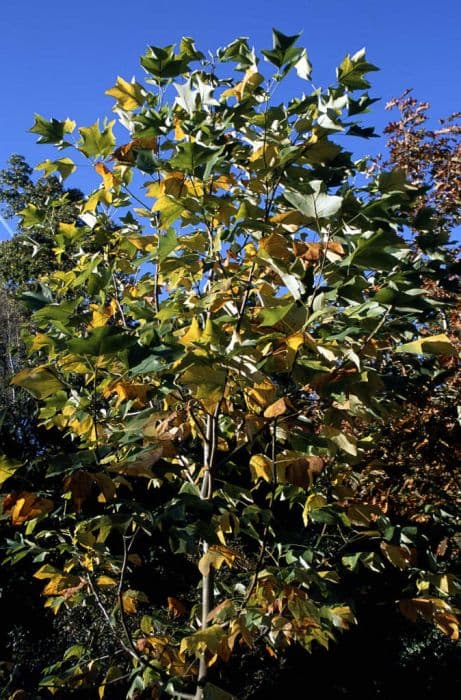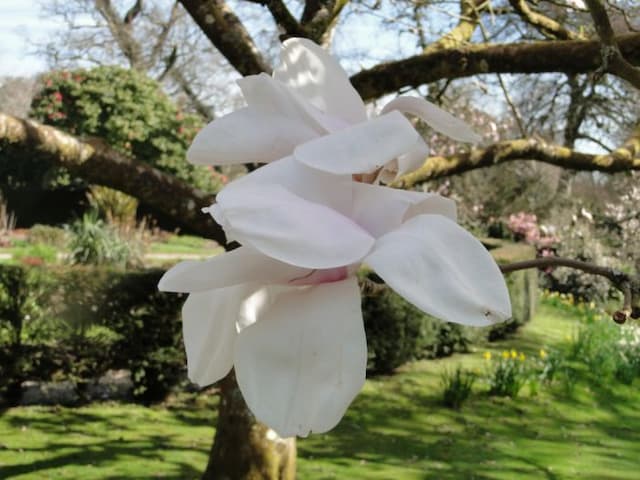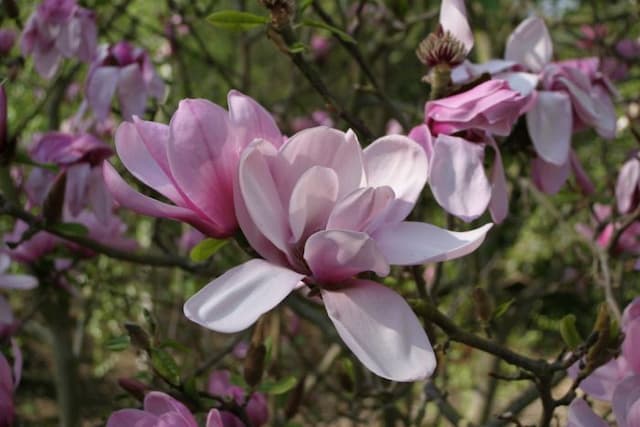Loebner magnolia Magnolia × loebneri 'Merrill'

ABOUT
Magnolia × loebneri 'Merrill', commonly known as Loebner magnolia, is a widely admired ornamental plant known for its splendid floral display. It proudly bears a profusion of large, star-shaped flowers that emerge before the foliage in early spring. The blooms are typically pure white to pink-tinged and consist of numerous narrow petals that radiate from the center, creating a slightly fragrant and ethereal effect that captivates onlookers. As the flowers wane, the plant's leaves unfurl, revealing a fresh, verdant green canopy. These leaves are oval-shaped with a glossy texture and a lush appearance that provides a beautiful backdrop to the fading blossoms. As seasons change, the foliage holds its color before yielding to autumn's touch, at which point it might change hues before falling. The branching structure of the Loebner magnolia is multi-stemmed and spreading, often contributing to an overall rounded and pleasing form that adds to its attractiveness throughout the year. The bark is smooth and gray, adding further interest, especially in the winter months when the tree is leafless. In terms of its visual impact in a garden or landscape setting, this magnolia graces the environment with a majestic floral show in spring and offers a serene green presence during summer, while its structural qualities are appreciated in the colder months. It is a cherished specimen for its ornamental beauty, capturing the essence of spring with its bountiful blossoms and contributing to the year-round aesthetic appeal of a landscape.
About this plant
 Names
NamesFamily
Magnoliaceae
Synonyms
Loebner Magnolia, Merrill Magnolia
Common names
Magnolia × loebneri 'Merrill'.
 Toxicity
ToxicityTo humans
Loebner magnolia (Magnolia × loebneri 'Merrill') is generally considered to be non-toxic to humans. Ingesting parts of this plant is not known to cause poisoning or serious side effects. Therefore, no specific symptoms of poisoning are commonly associated with it as it is not regarded as a poisonous plant to humans.
To pets
Loebner magnolia (Magnolia × loebneri 'Merrill') is also considered to be non-toxic to pets. It does not pose a risk of poisoning if pets consume parts of the plant, and there are no known toxic effects or specific symptoms associated with its ingestion by animals such as dogs or cats.
 Characteristics
CharacteristicsLife cycle
Perennials
Foliage type
Deciduous
Color of leaves
Green
Flower color
White
Height
20-30 feet (6-9 meters)
Spread
20-30 feet (6-9 meters)
Plant type
Tree
Hardiness zones
5-9
Native area
Hybrid origin
Benefits
 General Benefits
General Benefits- Ornamental Value: The Magnolia × loebneri 'Merrill', commonly known as Loebner Magnolia, has showy white flowers that add aesthetic appeal to gardens and landscapes.
- Spring Interest: It blooms early in spring, providing one of the first splashes of color after the winter season.
- Attracts Pollinators: The flowers provide nectar and attract bees, butterflies, and other beneficial pollinators to the garden.
- Shade Provision: As the tree matures, it can provide a moderate amount of shade in garden settings.
- Aromatic Flowers: The Loebner Magnolia's flowers emit a pleasant fragrance that can enhance the sensory experience of a garden.
- Compact Size: It is relatively small for a magnolia, making it suitable for smaller gardens or limited spaces.
- Low Maintenance: Once established, it requires minimal care beyond occasional watering and pruning.
- Fall Interest: In autumn, the leaves turn a golden bronze color, adding seasonal interest to the landscape.
- Tolerance of Conditions: It can tolerate a range of soil types, as long as they are well-drained.
- Cultural Significance: Magnolias have a long history of cultivation and are often associated with nobility and perseverance in various cultures.
 Medical Properties
Medical PropertiesThis plant is not used for medical purposes.
 Air-purifying Qualities
Air-purifying QualitiesThis plant is not specifically known for air purifying qualities.
 Other Uses
Other Uses- Magnolia Loebner can be used as a photographic subject for garden and nature photographers looking for stunning spring blooms to capture.
- The wood of Magnolia Loebner trees can be crafted into small pieces of furniture or turned into decorative wooden bowls and ornaments by skilled woodworkers.
- This plant's durable bark may be utilized in crafting and as a textural element in mixed-media art projects.
- Leaves from the Magnolia Loebner can be used in floral arrangements or as a natural backdrop for model photography, providing a lush green contrast.
- The petals of Magnolia Loebner can be used to make natural confetti for outdoor celebrations, leaving no harmful residue as it decomposes.
- Extracts from the flowers, while avoiding medical usage, can be used in perfumery for crafting unique, floral-scented fragrances.
- Dried Magnolia Loebner branches can be used as natural decor in home interiors, adding an organic and rustic touch to the living space.
- Fallen Magnolia Loebner petals can be collected and added to compost bins as a source of organic matter that helps improve soil structure over time.
- The seed cones can be used for crafting, as they provide an interesting texture and shape for homemade wreaths and dried arrangements.
- In educational settings, Magnolia Loebner can be a subject for botany studies, showcasing the characteristics of hybrid plants and their flowering processes.
Interesting Facts
 Feng Shui
Feng ShuiThe Loebner Magnolia is not used in Feng Shui practice.
 Zodiac Sign Compitability
Zodiac Sign CompitabilityThe Loebner Magnolia is not used in astrology practice.
 Plant Symbolism
Plant Symbolism- Perseverance and Endurance: Magnolias are known for their ability to withstand harsh conditions, thus symbolizing resilience.
- Nobility and Dignity: The elegant appearance of the Magnolia flowers, particularly that of Magnolia × loebneri 'Merrill', represents a sophisticated and respectable bearing.
- Purity and Innocence: The pristine white blooms of this magnolia convey a sense of purity and innocence.
- Beauty and Splendor: The impressive flowers of the 'Merrill' magnolia symbolize magnificent beauty and splendor.
- Feminine Sweetness and Gentleness: Often associated with the soft, feminine qualities, magnolia flowers can represent sweetness and gentleness.
 Water
WaterLoebner magnolia should be watered deeply once a week, providing about 1 to 1.5 gallons of water for younger trees and 2 to 3 gallons for established ones. During the growing season, if there has been no rain, increase watering to twice per week. It's essential to avoid overwatering; make sure the soil around the root zone is moist but not waterlogged. In the winter months, you can reduce watering since the plant will be dormant and the evaporation rates are lower.
 Light
LightLoebner magnolia thrives in full sun to partial shade. It prefers at least four hours of direct, unfiltered sunlight each day. The ideal spot for the plant is one where it receives morning sun and afternoon shade, especially in areas with hot summers.
 Temperature
TemperatureThe Loebner magnolia can typically withstand temperatures as low as 20°F but prefers a range between 60°F and 70°F. Avoid exposure to temperatures below this range as it could damage the buds and flowers. The maximum temperature for this plant is around 90°F, beyond which heat stress can occur.
 Pruning
PruningPrune Loebner magnolia to remove dead or broken branches and to shape the tree as needed, typically after flowering in late spring or early summer. If required, heavier pruning should be done during this time to avoid disrupting the blooming cycle.
 Cleaning
CleaningAs needed
 Soil
SoilLoebner magnolia 'Merrill' thrives in rich, well-draining soil with a pH from 5.0 to 6.5. A mix of loam, peat, and compost with some sand is ideal to ensure drainage and fertility.
 Repotting
RepottingLoebner magnolia 'Merrill' is typically planted in the garden rather than potted, so repotting is not commonly required. For young trees grown in containers, repot every 2-3 years.
 Humidity & Misting
Humidity & MistingLoebner magnolia 'Merrill' prefers average outdoor humidity levels; it does not require high humidity and adapts well to the ambient conditions in most temperate regions.
 Suitable locations
Suitable locationsIndoor
Grow Loebner magnolia 'Merrill' in a large pot with ample light.
Outdoor
Plant in sun to partial shade, sheltered from wind, and mulch well.
Hardiness zone
Loebner magnolia 'Merrill' suits USDA zones 4-9.
 Life cycle
Life cycleMagnolia × loebneri 'Merrill', commonly known as Loebner magnolia, begins its life cycle as a dormant seed, which after stratification during winter months, germinates in the spring. The seedling emerges and develops into a young sapling, establishing a root system and a small stem. As it matures, the sapling grows into a small tree with a branching structure and distinctive leafy growth. Each spring, Loebner magnolia enters a reproductive stage, featuring a profusion of fragrant, star-shaped white flowers, which are followed by seed cone-like fruit that mature by late summer or early fall. After fertilization, seeds are dispersed by wind or wildlife, completing the life cycle when they land in a suitable location for germination. Throughout its lifetime, which could be several decades, the Loebner magnolia goes through recurring cycles of growth, flowering, and seed production.
 Propogation
PropogationPropogation time
Spring
The ideal time for propagating Magnolia × loebneri 'Merrill', commonly known as Loebner magnolia, is during mid-summer to early fall. The most popular method of propagation for this magnolia is through semi-hardwood cuttings. This involves taking a cutting of about 4 to 6 inches long (10 to 15 centimeters) from a healthy parent plant, preferably from new growth that has started to mature but is not completely woody. The leaves on the lower half of the cutting should be removed, and the cut end dipped in rooting hormone to encourage root development. The cutting is then planted in a well-draining potting mix, ensuring at least two nodes are below the surface. It's kept in a humid environment with indirect light until roots develop, which can take several weeks to a few months. During this time, the cutting should be kept moist but not saturated to prevent rot.









![Magnolia [Felix Jury]](/_next/image?url=https%3A%2F%2Fplants-admin.emdemapps.com%2Fimages%2Fplants%2F%2Fimages%2F604b61a0b23b7.png&w=640&q=75)